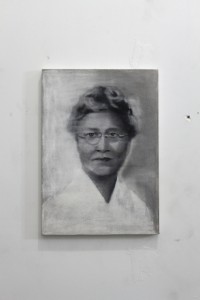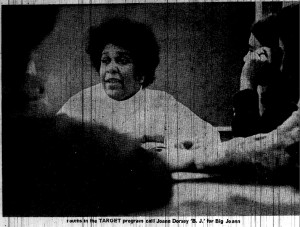As a new building on campus is being named after Maudelle Bousfield, the first African American woman to graduate from the University of Illinois, a public housing complex named after Joann Dorsey, black community activist in Champaign during the 1960s, 70s, and 80s, has been torn down. One woman came from the black upper class, the other from the working class, yet they both should be recognized for their contributions.

Portrait of Maudelle Brown Bousfield by Jason Patterson
Charcoal and pastel on raw canvas
under polymer glaze and varnish
14x20in, 2010-11
Pioneer Educator, Maudelle Bousfield
The University of Illinois’ Board of Trustees recently voted to designate a new residence hall, “Bousfield Hall,” bearing the name of Maudelle Tanner Brown Bousfield, who graduated from the University of Illinois in 1906. Bousfield was born June 1, 1885 in St. Louis to parents who were public school teachers. She was related to Henry Ossawa Tanner, the first major African American painter who gained a reputation while living in Paris. Also possessing an artist’s inclination, Bousfield took to the piano at an early age and attended the Charles Kunkel Conservatory of Music.
In 1903, Bousfield entered the University of Illinois. “There were four colored boys at the university,” she recalled, “and I was the only colored girl.” She first wanted to become an astronomer, but a professor discouraged her from pursuing a career in a profession that largely excluded women and African Americans. Instead, she studied to become a math teacher.
To pay for school, Bousfield tutored math students and played piano at sock hops. In the Chicago Defender she described life as one of five black students on campus: “On Sunday the five of us would go to one of the two black churches in Champaign and sit in the back; listen to the music and watch the services. There wasn’t anything else to do” (3/5/70).
She spent a period as a teacher before marrying a doctor, Midian Bousfield, and moving to Chicago in 1914. She took time off to start a family, and later returned to teaching in the Chicago public schools. This was a time when Chicago’s South Side was turning from white to black, as thousands of black migrants poured into the city from the South. In 1935, Bousfield was teaching at Douglass Grammar School, where there was a growing number of black teachers among the white faculty. “Colored teachers are an inspiration to students,” she said at the time, and “they exert a positive influence over the white staff.”
In 1939, Bousfield was named the first African American principal of a high school, presiding over Wendell Phillips High School on the South Side. When it was founded in 1904, Wendell Phillips was all-white, but during the 1920s it became the first high school in Chicago to become predominantly black. In 1935, the old building mysteriously burned down and the new Wendell Phillips High School was opened at 49th and Wabash Ave., where it still stands today. It was here that Bousfield was principal from 1939 until she retired in 1950.
Maudelle Bousfield and her husband, Midian Bousfield, were a prominent couple among Chicago’s black bourgeoisie. They were friends of Franklin and Eleanor Roosevelt. Midian Bousfield was a doctor at Provident Hospital which served black clients on the South Side. At this time, the health care system in the United States was Jim Crowed, with most white patients refusing to be treated by black doctors and nurses.
During World War II, Dr. Bousfield advocated for the formation of the Tuskegee airmen, the celebrated black fighter pilots. In 1942, he was appointed to oversee an all-black medical unit at Fort Huachuca, Arizona. At the time, black Communist Ishmael Flory criticized Dr. Bousfield as an “Uncle Tom” for taking charge of a Jim Crow unit. Yet, due in part to the service of men like Bousfield, Army medical units were integrated in 1945. In 1948, he would die of a heart attack, leaving Maudelle Bousfield to pursue new interests.
In 1950, Maudelle Bousfield retired from the Chicago public schools, but she remained an active volunteer. An avid gardener, for three years she wrote a column for the Chicago Defender called “Let’s Grow a Garden.” In the first article dated March 8, 1958, she explained, “I’d like to pass on to you, thru these weekly articles, information I know will save you many mistakes, save money and labor, and give you joy and beauty in your home and your community.”
Maudelle Bousfield died in 1971 at the age of 86. In what was to be one of her last interviews she addressed the children: “I would like to say to every child to try and realize that education is the most important task they can engage in. Without an education, there will only be a few job opportunities open to them after they become adults.”
Joann Dorsey, “A Little Rosa Parks”
Joann Dorsey also loved children. She had a total of 12 children, nine sons and three daughters. To those who remember her, Joann Dorsey was an advocate for the black community in areas of housing, jobs, and health care. After she passed away in 1990, members of the black community lobbied to have the public housing units at Bradley and McKinley Ave. named after her.
Joann Valentine Dorsey was born October 17, 1932 in Chicago. Her family moved to Champaign in 1937 where she attended Lawhead Elementary School, located in the Douglass Park neighborhood, a school that was built for children of European immigrants, predominantly Germans and Italians, but by the 1930s was segregated for blacks. She attended Central High School, before moving to New York in 1948.
There is little known about Dorsey during the 1950s and 1960s, years when she was raising children. In 1969, she was working with the Department of Mental Health in Champaign. She helped to establish a not-for-profit housing development. She was a founding member of the Community Advocacy Depot, among those who initiated the Martin Luther King subdivision, and a member of the local Urban League. In 1974 she was appointed to head a program at the juvenile detention center targeted at preventing youth from ending up in corrections. “The major thing,” she said, “is that the kids know you care about them.”
She worked with the Frances Nelson Health Center, a Jail-Courts Complex advisory committee, the Gemini House (now the Prairie Center), and the Welfare Rights Organization.
Dorsey is perhaps best known as chair of the Concerned Citizens Committee (CCC), a group made up of John Lee Johnson, Terry Townsend, Ted Atkinson, and others.
Working with the CCC, she spearheaded food drives during Thanksgiving and Christmas. As Ted Atkinson remembered, whenever people had problems, they would come to her. “She was a little Rosa Parks,” he said.
After she died on September 7, 1990, a successful effort was led by Terry Townsend and the CCC to have the public housing units at Bradley and McKinley named after Dorsey. To local residents, they became known as the “Dorsey homes.” However, due to years of neglect, and a shortage of affordable housing in Champaign-Urbana, poverty became concentrated in the apartments.
In the summer of 2012, the Housing Authority leveled the buildings. They are to be replaced by mixed-income townhouses and renamed “Providence at Sycamore Hills.” As developer Torian Priestly told the News-Gazette, “it looks nothing like affordable housing, it has a market-rate feel.”
I asked Terry Townsend what he thought about the name change. “It’s a terrible thing they’re doing,” he said. “It’s insulting, I think.”
The stories of these equally inspiring black women―Maudelle Bousfield and Joann Dorsey―should be remembered. While buildings can be built and torn down, stories can live on.
Thanks to Michael Burns, Noah Lenstra, and the librarians at the Champaign County Historical Archives for help researching Joann Dorsey.

